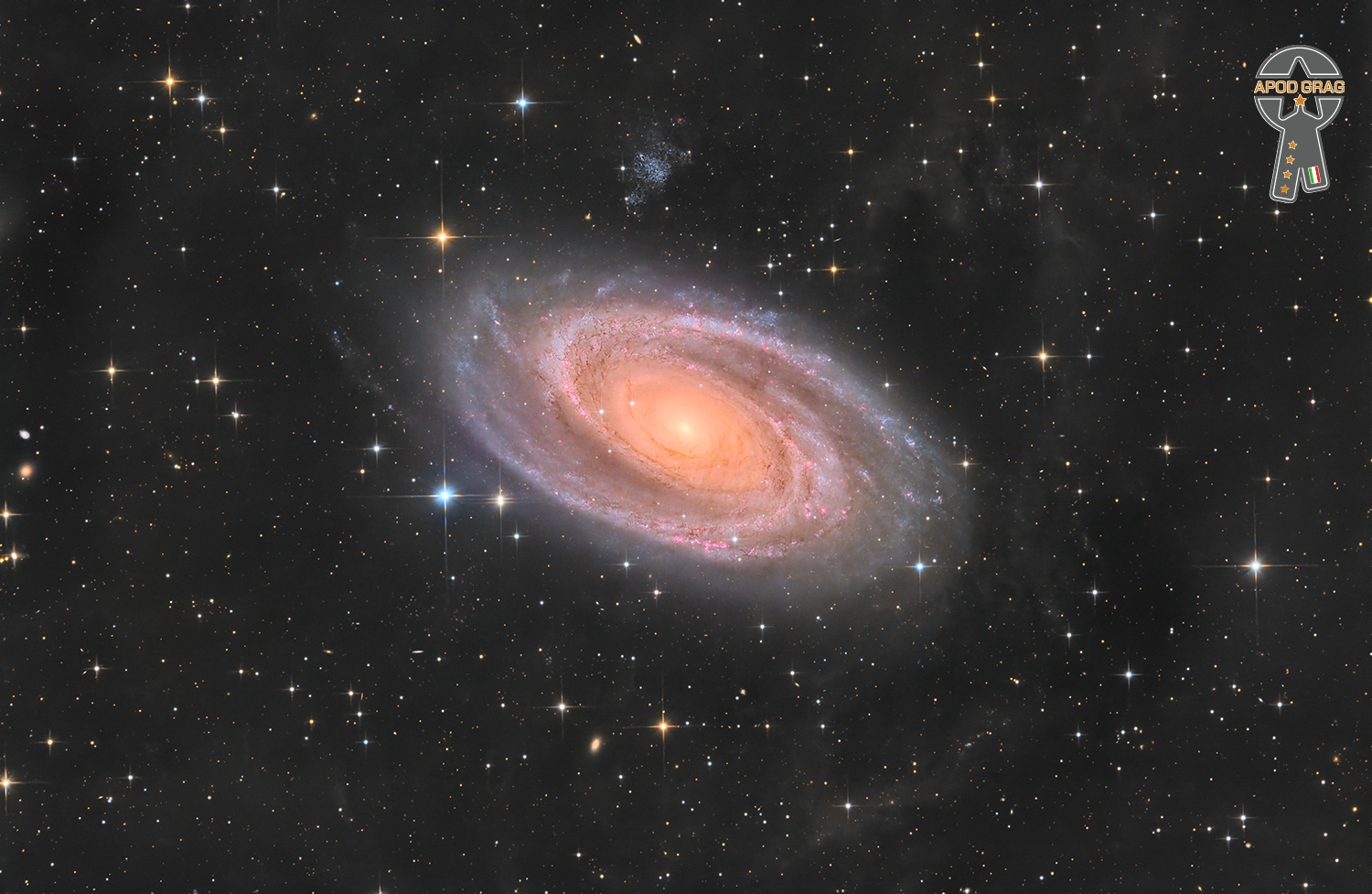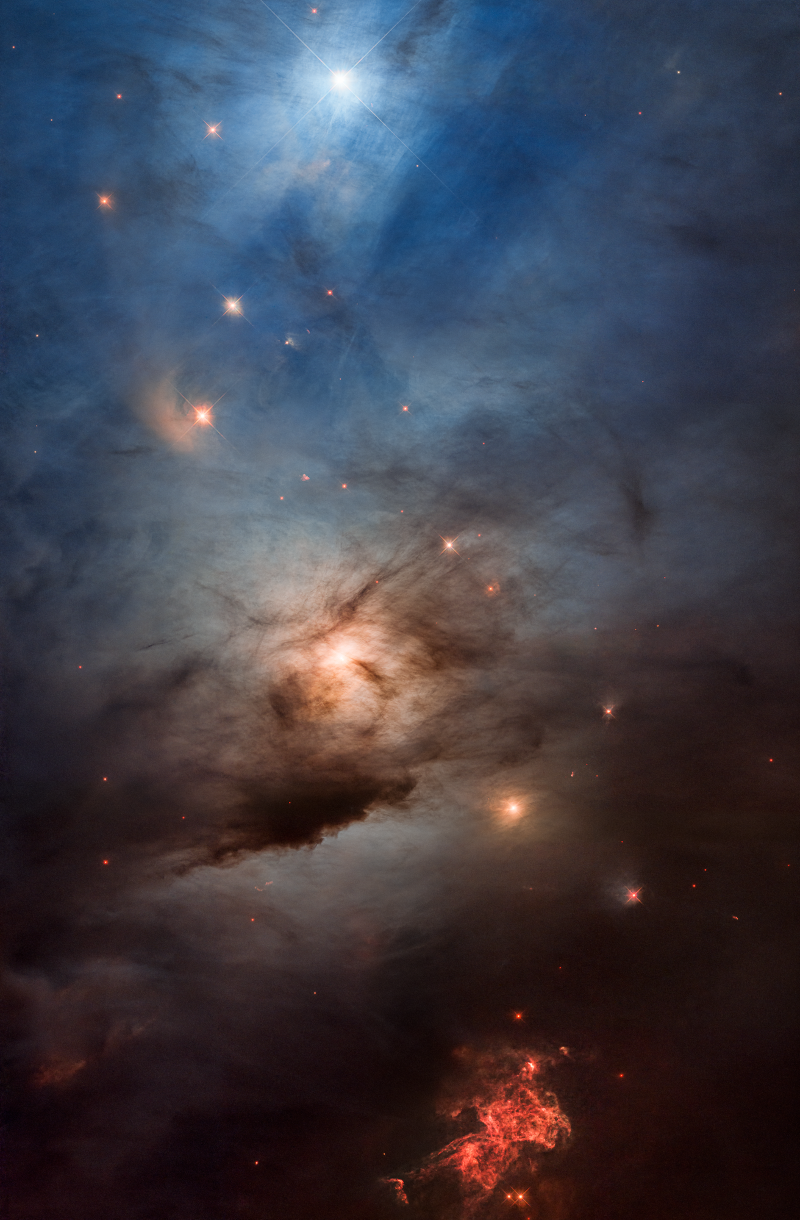Blog
M81 is a spiral galaxy with a relatively modest diameter of 60,000 light years. In 1993, the observation of about thirty cepheids by the Hubble telescope made it possible to estimate the distance of the galaxy at 11.8 million light years, making it one of the closest to ours. It is part of the same group of galaxies as M82, the G2 group (list of Vaucouleurs). This group is part of the supercluster of the Virgin, as is our local group.
M81 cannot be seen without an instrument. It is clearly visible with binoculars because of its magnitude of 6.9. In a 114 mm telescope, the nucleus appears as bright and surrounded by a diffuse halo. A 350 mm instrument and good observation conditions are needed to detect the spiral arms of the galaxy.

William P. Homans III, (born 1949) professionally known as “Watermelon Slim”, is an American bluesmusician. He plays both guitar and harmonica. He is currently signed to NorthernBlues Music, based in Toronto, Ontario. Homans has also earned bachelor’s and master’s degrees from University of Oregon and Oklahoma State University.
Homans was born in Boston, Massachusetts, United States, but has said that he was raised in North Carolina, where he was first exposed to blues music from about the time he was five years old. During childhood, he sang in choirs and glee clubs. Homans later explained that he first played music in 1958, on a set of bongo drums. A year later, he acquired a harmonica. It took almost a decade before he became sufficiently experienced to take on a professional gig at Middlebury College in Vermont.
more...Albert Nelson (April 25, 1923 – December 21, 1992), known by his stage name Albert King, was an American guitarist and singer who is often regarded as one of the greatest and most influential bluesguitarists of all time. He is perhaps best known for his popular and influential album Born Under a Bad Sign (1967) and its title track. He, B.B. King, and Freddie King, all unrelated, were known as the “Kings of the Blues”. The left-handed King was known for his “deep, dramatic sound that was widely imitated by both blues and rock guitarists.”
He was once nicknamed “The Velvet Bulldozer” because of his smooth singing and large size–he stood taller than average, with sources reporting 6 ft 4 in (1.93 m) or 6 ft 7 in (2.01 m), and weighed 250 lb (110 kg) – and also because he drove a bulldozer in one of his day jobs early in his career.
King was inducted into the Blues Hall of Fame in 1983. He was posthumously inducted into the Rock and Roll Hall of Fame in 2013. In 2011, he was ranked number 13 on Rolling Stone‘s 100 Greatest Guitarists of All Time.
Albert King was born on a cotton plantation in Indianola, Mississippi. During childhood he sang at a church with a family gospel group, in which his father played the guitar. One of 13 children, he grew up picking cotton on plantations near Forrest City, Arkansas, where the family moved when he was eight years old.
more...Ella Jane Fitzgerald (April 25, 1917 – June 15, 1996) was an American jazz singer, sometimes referred to as the “First Lady of Song”, “Queen of Jazz”, and “Lady Ella”. She was noted for her purity of tone, impeccable diction, phrasing, timing, intonation, and a “horn-like” improvisational ability, particularly in her scat singing.
After a tumultuous adolescence, Fitzgerald found stability in musical success with the Chick Webb Orchestra, performing across the country but most often associated with the Savoy Ballroom in Harlem. Her rendition of the nursery rhyme “A-Tisket, A-Tasket” helped boost both her and Webb to national fame. After taking over the band when Webb died, Fitzgerald left it behind in 1942 to start her solo career. Her manager was Moe Gale, co-founder of the Savoy, until she turned the rest of her career over to Norman Granz, who founded Verve Records to produce new records by Fitzgerald. With Verve she recorded some of her more widely noted works, particularly her interpretations of the Great American Songbook.
While Fitzgerald appeared in films and as a guest on popular television shows in the second half of the twentieth century, her musical collaborations with Louis Armstrong, Duke Ellington, and The Ink Spots were some of her most notable acts outside her solo career. These partnerships produced some of her best-known songs such as “Dream a Little Dream of Me“, “Cheek to Cheek“, “Into Each Life Some Rain Must Fall“, and “It Don’t Mean a Thing (If It Ain’t Got That Swing)“. In 1993, after a career of nearly sixty years, she gave her last public performance. Three years later, she died at age 79 after years of declining health. Her accoladesincluded 14 Grammy Awards, the National Medal of Arts, the NAACP‘s inaugural President’s Award, and the Presidential Medal of Freedom.
Fitzgerald was born on April 25, 1917, in Newport News, Virginia. She was the daughter of William Fitzgerald and Temperance “Tempie” Henry, both described as “mulatto” in the 1920 census. Her parents were unmarried but lived together in the East End section of Newport News for at least two and a half years after she was born. In the early 1920s, Fitzgerald’s mother and her new partner, a Portuguese immigrant named Joseph da Silva, moved to Yonkers, in Westchester County, New York.
more...A menagerie of interesting astronomical finds fill this image from the NASA/ESA Hubble Space Telescope. As well as several large elliptical galaxies, a ring-shaped galaxy is lurking on the right of this image. A pair of bright stars are also visible at the left of this image, notable for their colourful criss-crossing diffraction spikes. This collection of astronomical curiosities is the galaxy cluster ACO S520 in the constellation Pictor, which was captured by Hubble’s Advanced Camera for Surveys. This is one of a series of Hubble observations searching for massive, luminous galaxy clusters that had not been captured by earlier surveys. Appropriately, the proposal for observing time was named “They almost got away”! Astronomers took advantage of occasional gaps in Hubble’s busy schedule to capture images of these barely-explored galaxy clusters, revealing a wealth of interesting targets for further study with Hubble and the NASA/ESA/CSA James Webb Space Telescope. Galaxy clusters are among the largest known objects in the Universe, and studying these objects can provide insights into the distribution of dark matter, which is responsible for most of the mass of a galaxy cluster. The vast masses of galaxy clusters is what causes many of them to act as gravitational lenses which distort and magnify light from even more distant objects. This can allow astronomers to use galaxy clusters as a kind of natural gravitational telescope to reveal distant objects that would usually be too faint to resolve — even for the crystal-clear vision of Hubble. [Image description: A collection of oval-shaped, elliptical galaxies. The largest has two neighbouring bright spots in the core. It and two others look like galaxy clusters, with surrounding smaller galaxies. On the left edge of the image are two bright stars with four long spikes, and on the right edge is a small ring-shaped galaxy. Smaller stars and galaxies are spread evenly across the dark background.]

John Christopher Williams AO OBE (born 24 April 1941) is an Australian virtuosic classical guitarist renowned for his ensemble playing as well as his interpretation and promotion of the modern classical guitar repertoire. In 1973, he shared a Grammy Award in the Best Chamber Music Performance category with fellow guitarist Julian Bream for Together (released in the US as Julian and John (Works by Lawes, Carulli, Albéniz, Granados)). Guitar historian Graham Wade has said that “John is perhaps the most technically accomplished guitarist the world has seen.
more...Joe Henderson (April 24, 1937 – June 30, 2001) was an American jazz tenor saxophonist. In a career spanning more than four decades, Henderson played with many of the leading American players of his day and recorded for several prominent labels, including Blue Note, Milestone, and Verve.
Born in Lima, Ohio, United States, Henderson was one of fourteen children. He was encouraged by his parents Dennis and Irene (née Farley) and older brother James T. to study music. He dedicated his first album to them “for being so understanding and tolerant” during his formative years. Early musical interests included drums, piano, saxophone and composition. According to Kenny Dorham, two local piano teachers who went to school with Henderson’s brothers and sisters, Richard Patterson and Don Hurless, gave him a knowledge of the piano. He was particularly enamored of his brother’s record collection. It seems that a hometown drummer, John Jarette, advised Henderson to listen to musicians like Lester Young, Stan Getz, Dexter Gordon and Charlie Parker. He also liked Flip Phillips, Lee Konitz and the Jazz at the Philharmonic recordings. However, Parker became his greatest inspiration. His first approach to the saxophone was under the tutelage of Herbert Murphy in high school. In this period of time, he wrote several scores for the school band.
more...John Arnold Griffin III (April 24, 1928 – July 25, 2008) was an American jazz tenor saxophonist. Nicknamed “the Little Giant” for his short stature and forceful playing, Griffin’s career began in the mid-1940s and continued until the month of his death. A pioneering figure in hard bop, Griffin recorded prolifically as a bandleader in addition to stints with pianist Thelonious Monk, drummer Art Blakey, in partnership with fellow tenor Eddie “Lockjaw” Davis and as a member of the Kenny Clarke/Francy Boland Big Band after he moved to Europe in the 1960s. In 1995, Griffin was awarded an Honorary Doctorate of Music from Berklee College of Music.
Griffin studied music at DuSable High School in Chicago under Walter Dyett, starting out on clarinet before moving on to oboe and then alto saxophone. While still at high school at the age of 15, Griffin was playing with T-Bone Walker in a band led by Walker’s brother.
more...Pictured here is one of the better images yet recorded of a waterspout, a type of tornado that occurs over water. Waterspouts are spinning columns of rising moist air that typically form over warm water. Waterspouts can be as dangerous as tornadoes and can feature wind speeds over 200 kilometers per hour. Some waterspouts form away from thunderstorms and even during relatively fair weather. Waterspouts may be relatively transparent and initially visible only by an unusual pattern they create on the water. The featured imagewas taken in 2013 July near Tampa Bay, Florida. The Atlantic Ocean off the coast of Florida is arguably the most active area in the world for waterspouts, with hundreds forming each year. 
Roy Kelton Orbison (April 23, 1936 – December 6, 1988) Vernon, TX was an American singer, songwriter, and musician known for his impassioned singing style, complex song structures, and dark, emotional ballads. His music was described by critics as operatic, earning him the nicknames “The Caruso of Rock” and “The Big O.” Many of Orbison’s songs conveyed vulnerability at a time when most male rock-and-roll performers chose to project machismo. He performed while standing motionless and wearing black clothes to match his dyed black hair and dark sunglasses.
more...Vernice “Bunky” Green (born April 23, 1933) is an American jazz alto saxophonist and educator.
Green was raised in Milwaukee, Wisconsin, where he played the alto saxophone, mainly at a local club called “The Brass Rail”.
Green’s first break came when he was hired in New York City by Charles Mingus as a replacement for Jackie McLean in the 1950s. His brief stint with the bass player and composer made a deep impression. Mingus’ sparing use of notation and his belief that there was no such thing as a wrong note had a lasting influence on Green’s own style.
more...Charles Edward “Cow Cow” Davenport (April 23, 1894 – December 3, 1955) was an American boogie-woogie and piano blues player as well as a vaudeville entertainer. He also played the organ and sang.
Davenport, who also made recordings under the pseudonyms of Bat The Humming Bird, George Hamilton and The Georgia Grinder, is a member of the Alabama Music Hall of Fame.
He was born in Anniston, Alabama, United States, one of eight children. Davenport started to play the piano at age 12. His father objected strongly to his musical aspirations and sent him to a theological seminary, where he was expelled for playing ragtime.
Davenport’s career began in the 1920s when he joined the K.G. Barkoot Traveling Carnival. His initial profile came as accompanist to blues musicians Dora Carr and Ivy Smith. Davenport and Carr performed as a vaudeville act as “Davenport & Co”, and he performed with Smith as the “Chicago Steppers”. He also performed with Tampa Red. Davenport recorded for many record labels, and was a talent scout and artist for Vocalion Records. Davenport suffered a stroke in 1938 and lost movement in his hands. He was washing dishes when he was found by the jazz pianist Art Hodes. Hodes assisted in his rehabilitation and helped him find new recording contracts.
more...In visible light NGC 1333 is seen as a reflection nebula, dominated by bluish hues characteristic of starlight reflected by interstellar dust. A mere 1,000 light-years distant toward the heroic constellationPerseus, it lies at the edge of a large, star-forming molecular cloud. This Hubble Space Telescope close-up frames a region just over 1 light-year wide at the estimated distance of NGC 1333. It shows details of the dusty region along with telltale hints of contrasty red emission from Herbig-Haro objects, jets and shocked glowing gas emanating from recently formed stars. In fact, NGC 1333 contains hundreds of stars less than a million years old, most still hidden from optical telescopes by the pervasive stardust. The chaotic environment may be similar to one in which our own Sun formed over 4.5 billion years ago. Hubble’s stunning image of the stellar nursery was released to celebrate the 33rd anniversary of the space telescope’s launch.

More Posts
- Henry “Rubberlegs” Williams Day
- World Music with Noe hernandez cantarell
- Daily Roots with Barry Brown
- The Cosmos with NGC 3627
- Albert Ayler Day
- Pete Escovedo Day
- World Music with Paco de Lucia
- Daily Roots with Michael Rose
- The Cosmos with RCW38
- Big John Patton Day
- Paul Gonsalves Day
- World Music with Martá Sebestyén
- Daily Roots with Prince Buster
- The Cosmos with R Aquarii
- Tomasz Stanko Day
- Clyde Bernhardt Day
- World Music with Diali Cissokho & Kaira Ba
- Daily Roots with Linval Thompson
- The Cosmos with NGC 3576
- Bela Fleck Day
